Princess Isabella of Parma
Princess Isabella of Parma (Isabella Maria Luisa Antonietta Ferdinanda Giuseppina Giuseppa Saveria Domenica Giovanna; 31 December 1741 – 27 November 1763) was the eldest child of Philip, Duke of Parma and Louise Élisabeth, daughter of Louis XV of France and Maria Leszczyńska. At age 18 Isabella was married to Archduke Joseph of Austria, with whom she was not happy, finding more fulfilment in her “close friendship” with his sister Maria Christina. The difficult birth of her daughter Maria Theresa, followed by two miscarriages, affected her mental condition, and she died soon after giving birth to another stillborn daughter.
| Princess Isabella of Parma | |||||
|---|---|---|---|---|---|
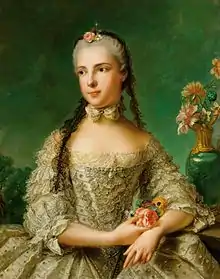 Portrait by Jean-Marc Nattier | |||||
| Born | 31 December 1741 Buen Retiro Palace, Madrid, Spain | ||||
| Died | 27 November 1763 (aged 21) Schönbrunn Palace, Vienna, Austria | ||||
| Burial | Imperial Crypt, Vienna | ||||
| Spouse | |||||
| Issue |
| ||||
| |||||
| House | Bourbon-Parma | ||||
| Father | Philip, Duke of Parma | ||||
| Mother | Louise Élisabeth of France | ||||
| Religion | Roman Catholicism | ||||
Life
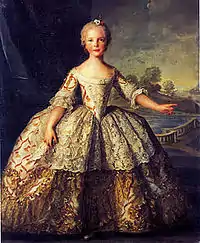
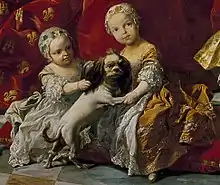
Born Isabella Maria Luisa Antonietta Ferdinanda Giuseppina Saveria Domenica Giovanna at Buen Retiro Palace in Madrid, Isabella was an Infanta of Spain and grew up at the court of her grandfather Philip V of Spain. Her father was the Spanish Prince Philip, who was Duke of Parma in Italy. Her mother was the 14-year-old Élisabeth of France, the eldest daughter of Louis XV of France. Isabella's parents' marriage was not happy, and for nearly 10 years Isabella remained an only child. Isabella was very close to her mother and was distraught when she died of smallpox in 1759. Henceforth, Isabella was convinced she would die young, as well.
Marriage
In 1760 a marriage was arranged between Isabella and Archduke Joseph of Austria, heir to the Habsburg monarchy. After a marriage by proxy, Isabella was escorted to Austria. On 6 October 1760, at the age of 18, Isabella married Joseph II in a ceremony lasting a couple days, the wedding festivities being recorded in paintings by Martin van Meytens.[1] Joseph was thrilled with his new bride and overwhelmed Isabella with his love. In return, she increasingly locked herself away, so much so that shortly after their wedding Isabella was plunged into melancholy. This marriage signaled the first marital union of Philip I of Castile's most senior descendant (by absolute primogeniture) with the Royal House of Habsburg-Lorraine.
Relationship with Maria Christina
The Princess spent most of her time in the Viennese court with her husband’s sister, Archduchess Maria Christina. The two women seemed to have had a romantic lesbian affair.[2][3] During the few years Isabella and Maria knew each other, they exchanged 200 letters and "billets" while living at the same court.[4][5] They spent so much time together that they earned the comparison with Orpheus and Eurydice.
Isabella and Maria were united not only by a shared interest in music and art but also by a deep mutual love.[6] However Isabella was unhappy in this love affair. To her it was the grand passion of her life, whereas for Maria Christina it was obviously merely one of these attachments to a woman which many girls form before they are married. Isabella grieved not only because she was more fond of Maria Christina than her sister-in-law was of her, but also because it meant a nervous tension to conceal this emotional struggle from her husband. Isabella's constant conflict between her sense of duty as a prince's wife and her feelings for Maria Christina made her feel guilty, and this had a disastrous effect on her mental health. The problem before her seemed insoluble and, increasingly, the thought of death occupied her mind and seemed the only escape from her emotional impasse.[7]
Isabella spent most of the hours when she was separated from her sister-in-law writing to her. They wrote long letters to each other in which they revealed their feelings. While the letters of Maria Christina showed her happy nature, Isabella's feelings were mixed and, in her expressions of affection, showed a certain pessimism, reflecting her growing obsession with death.[7]
In one such letter, Isabella wrote:
- "I am writing you again, cruel sister, though I have only just left you. I cannot bear waiting to know my fate, and to learn whether you consider me a person worthy of your love, or whether you would like to fling me into the river. I cannot tolerate this uncertainty, I can think of nothing but that I am madly in love. If only I knew why this is so, for you are so cruel that one should not love you, but I cannot help myself".
In a different letter, she wrote: "I am told that the day begins with God. I, however, begin the day by thinking of the object of my love, for I think of her incessantly."[7]
Only the letters of Isabella have been preserved; those of Maria Christina were destroyed after her death.
Pregnancies and depression
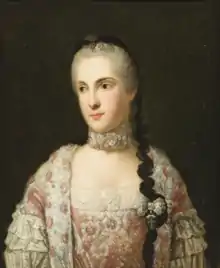
However, as wife of the heir to the throne, Isabella knew that her duty was to give birth to a healthy heir. Despite this, the Princess developed disquieted feelings toward her husband, spurred by anxieties over sexual intimacy and the possibilities of pregnancy.
By late 1761, one year into the marriage, Isabella became pregnant. It was an especially difficult pregnancy, and due to that Isabella suffered symptoms of physical illness, melancholy and lingering fears of death. Joseph, infatuated and inexperienced, failed to fully understand his wife's misery. On 20 March 1762, after nine months of mental and physical strain, Isabella gave birth to a daughter they named Maria Theresa. Isabella remained bedridden for 6 weeks after giving birth.
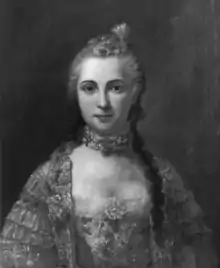
In August 1762 and January 1763 Isabella suffered two separate miscarriages that aggravated her mental unrest, causing her to fall into a depression that eroded her will to live.[8]
In 1763, Isabella was six months pregnant with a girl when she contracted smallpox. This brought on a premature labor ending in the death of the child, who was given the name Maria Christina hastily after Isabella had given birth, a few hours after birth. In total, out of four pregnancies, only one child survived infancy.[lower-alpha 1]
Death, burial and aftermath
Isabella followed her daughter in death at the Schönbrunn Palace in 1763, a week after giving birth to her. She was buried in Empress Maria Theresa's vault in the Imperial Crypt Vaults in Vienna. Joseph could not find comfort and did not recover from the death of his wife.
His second marriage (January 1765 – May 1767) to Princess Maria Josepha of Bavaria was unhappy and did not produce children. Subsequently, in August 1765, Isabella's father-in-law Francis I, Holy Roman Emperor died, and Joseph succeeded him as Holy Roman Emperor with the title of Joseph II.
Isabella had predicted even before her death that their daughter would follow the same road shortly after. Her forebodings were fulfilled on 23 January 1770, when the little Archduchess Maria Theresa died at age 7 due to pleurisy. The loss was overwhelming for Joseph. After the death of his only child, Joseph withdrew increasingly from public life.
.JPG.webp)
Issue
| Name | Birth | Death | Notes |
|---|---|---|---|
| Archduchess Maria Theresa | 20 March 1762 | 23 January 1770 | Died aged 7 of pleurisy. |
| Child* | August 1762 | August 1762 | Suffered a miscarriage. |
| Child* | January 1763 | January 1763 | Suffered a miscarriage. |
| Archduchess Maria Christina | 22 November 1763 | 22 November 1763 | Born three months premature and died shortly after birth. |
Ancestry
| Ancestors of Princess Isabella of Parma[10] |
|---|
Notes
- Historically, childbirth was the leading cause of death for women, as many as 1:5, until the mid-20th century.[9]
References
- "Isabella of Parma". Die Welt der Habsburger. Retrieved 6 February 2022.
- Simon Sebag Montefiore, Catherine the Great and Potemkin: The Imperial Love Affair, London, 2010
- Justin C. Vovk, In Destiny's Hands: Five Tragic Rulers, Children of Maria Theresa, USA, 2010
- Archives Nationales de Vienne, Autriche; Der Gruftwächter, play by Kafka; Simon Sebag Montefiore, Catherine the Great and Potemkin: The Imperial Love Affair, London, 2010
- Justin C. Vovk, In Destiny's Hands: Five Tragic Rulers, Children of Maria Theresa, USA, 2010
- Farquhar, Michael (2001). A Treasury of Royal Scandals: The Shocking True Stories of History's Wickedest, Weirdest, Most Wanton Kings, Queens, Tsars, Popes, and Emperors. Penguin Books. pp. 91. ISBN 9780140280241.
- Margaret Goldsmith (1936). "Maria Theresia of Austria". univie.ac.at. Retrieved 16 February 2018.
- "Melancholy Princess: Isabella of Parma". Royal Central. 14 May 2018. Retrieved 5 February 2022.
- "Unsurped title". Archived from the original on 26 June 2014.
{{cite web}}: CS1 maint: unfit URL (link) - Genealogie ascendante jusqu'au quatrieme degre inclusivement de tous les Rois et Princes de maisons souveraines de l'Europe actuellement vivans [Genealogy up to the fourth degree inclusive of all the Kings and Princes of sovereign houses of Europe currently living] (in French). Bourdeaux: Frederic Guillaume Birnstiel. 1768. p. 96.
External links
| Wikimedia Commons has media related to Princess Isabella of Parma. |
.svg.png.webp)